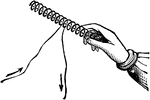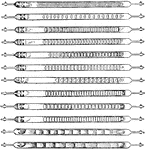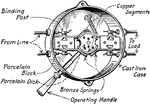This science ClipArt gallery offers 245 illustrations of basic concepts, experiments, apparatus, and systems proving properties and concepts in electricity.
!["The Metre Bridge is employed - a piece of apparatus which is illustrated [here]. It consists of a wooden base, upon the upper face of which is mounted a metallic rectangle; three sides of this rectangle are formed by a broad substantial copper band - having a negligible resistance - and the fourth consists of a platinum silver wire w w joining the copper blocks P and p. This wire is exactly one meter long, and over it slides a key K, which when depressed makes contact by means of a platinum knife-edge with the wire; the exact point on the wire at which this contact is made is indicated by an arrow-head on the key, which slides against a scale, as shown." (Britannica, 1891)](https://etc.usf.edu/clipart/61300/61365/61365_metre-bridge_mth.gif)
Metre Bridge
"The Metre Bridge is employed - a piece of apparatus which is illustrated [here]. It consists of a wooden…
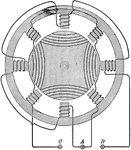
Altenating Current Motor
"...consists of a circular, multipolar field magnet, inclusing a cylinder armature with coils wound…

Alternating Current Motor Installed
"Illustration showing the installation of an alternating current motor." —Croft 1920
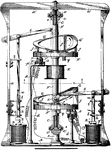
Electric Battery Operated Motor
An electric motor is a motor that uses electrical energy to produce mechanical energy, usually through…
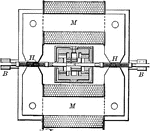
Tesla's Oscillator
"Tesla's oscillator is a combined prime motor and electric generator, and produces alternating currents…

Plate Electrical Machine
"When large quantities of electrical fluid are wanted for experiment, or for other purposes, it is procured…

Potentiometer
A potentiometer instrument for measuring the potential (or voltage) in a circuit taps off a fraction…

Power Generator
This electric generator is a device that converts mechanical energy to electrical energy. The reverse…
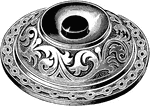
Push Button
"The push-button...is well known in connection with the electric bell: a brass spring which forms part…

Quadrant Electrometer
"Elevation and section of Thomson's Quadrant Electrometer." — Encyclopedia Britannica, 1893

Bell Receiver
The Bell receiver reproduces sounds made on the other end of the circuit, from a transmitter of some…
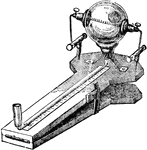
Reibungselectricitat
"This instrument consists of a glass tube of narrow bore, 16 to 17 inches long, to which is blown a…

Resistance Box
"When the brass plugs are inserted...the coils are short-circuited, i.e., practically, the whole of…

Rheostat
An instrument for regulating or adjusting a circuit so that any required degree of resistance may be…
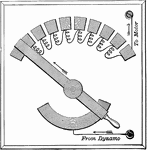
Rheostat
"The rheostat is an apparatus for admitting the current to the motor gradually, so as not to heat and…
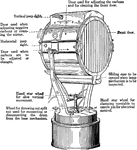
Searchlight
"An instrument for directing a powerful beam of electric light for the purpose of search, illumination,…
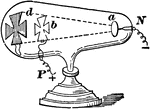
Shadow Tube
a is called the cathode, b is a plate of metal mounted inside the tube and in the path of the rays;…

Shunt
"A shunt, in electricity, is a conductor placed between two points in closed circuit, to divert or shunt…
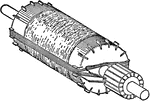
Siemens' Drum Winding
"Illustrating the principle of Siemens' drum winding. In order to make the winding and connections clear,…
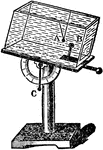
Sine Electrometer
"The sine electrometer of August, is a modification of the single pendulum electroscope, analogous in…

A Conductor Featuring a Spark Arrestor
A spark arrestor is a device intended to prevent combustible materials, usually sparks or other tiny…
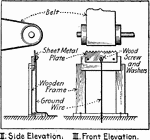
Using a Grounded Metallic Comb to Reduce Static Charge, Front and Side View
"Method of using a grounded metallic comb near the driving belt to relieve the belt of static charges."…
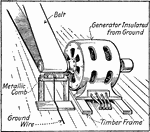
Using a Grounded Metallic Comb to Reduce Static Charge, Perspective View
"Method of using a grounded metallic comb near the driving belt to relieve the belt of static charges."…
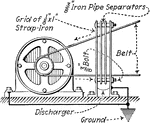
Static Discharger
"Multiple plate static discharger. (Grid should bridge both sides of belt and be as close to the motor…
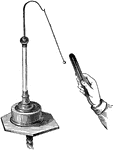
Demonstration of Static Electricity
A hand with bar demonstrating the attractive properties of static electricity.
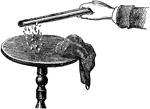
Demonstration of Static Electricity
A hand with a rod, demonstrating the attractive properties of static electricity.
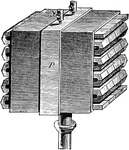
Thermomultiplier
An illustration of Macedonio Melloni's thermomultiplier, a combination of thermopile and galvanometer.

Thomsons Galvonometer
"A very convenient form of Thomson's galvanometer, the only specimen of its kind we have seen. The peculiarity…

Torsion Balance
"ABCD is a cylinder of glass 1 foot in diameter and 1 foot high. This cylinder is closed by a glass…

Blake transmitter
"The transmitter is a microphone adapted for the transmission of telephone messages and, in general…

Blake Transmitter
The Blake transmitter is used in taking voice and transferring it into an electrical signal that can…

Vibrator Coil
"Diagram of a vibrator coil. The parts are as follows: A, contact screw; B, battery; C, core; D, vibrator…
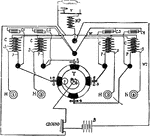
Master Vibrator Coil
"Circuit diagram of a master vibrator coil. B is the battery; C, the unit coils; C1, C2, etc. the condensors;…
Volta's Crown of Cups
"The metallic elements C and Z each conssted of two metals, the plate C being of copper and the plate…

Voltaic Pile
"Volta's arrangement for producing a current of electricity, consisting of a pile of alternate disks…

Faraday's Voltameter
"We may compare currents by the quantities of a given electrolyte which they decompose in a given time.…
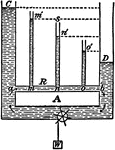
Voltmeter
"Showing method of connecting voltmeter to find potential differnce between any two points as m and…
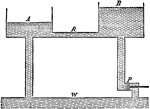
Analogy of Water Flow to Electric Current
"The water in resovoirs A and B stands at different heights. As long as this difference of level is…
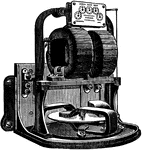
Wattmeter
"Instrument designed to measure both the rate at which the electrical energy is delivered and the time…
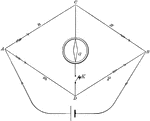
Wheatstone Bridge
"The Wheatstone bridge is used as a way to measure resistance of a unknown resitors." -Avery 1895
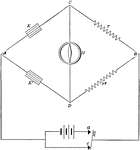
Wheatstone Bridge in Circuit
"The Wheatstone bridge is used as a way to measure resistance of a unknown resitors." -Avery 1895

Wheatstone Bridge with Resistors
"The Wheatstone bridge is used as a way to measure resistance of a unknown resitors." -Avery 1895

Wheatstones Bridge
"The best method for comparing resistances with great accuracy is the modification of Wheatstone's bridge…



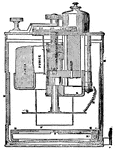
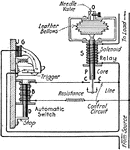
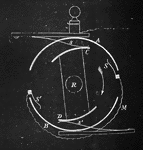


!["A typical direct-current starting rheostat is illustrated [here]." —Croft 1920](https://etc.usf.edu/clipart/36200/36223/rheostat_36223_mth.gif)

